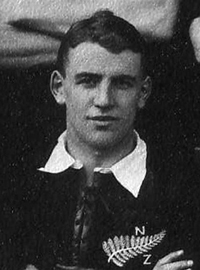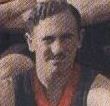Related Research Articles

George Ritchie Dickinson was a New Zealand cricketer and rugby union player. He played three tests for the New Zealand cricket team between 1930 and 1932, and five matches for the New Zealand national rugby side, the All Blacks, in 1922.
Norman Murray Parker is a former New Zealand cricketer who played in three Test matches and one One Day International during 1976.
Cricket in World War II was severely disrupted in most of the countries where first-class cricket is played. Only in India was a normal schedule of matches maintained throughout. In Australia, England, New Zealand, South Africa and West Indies the normal first-class competitions were suspended for some or all of the war and a small number of ad hoc first-class matches were organised when possible.
This article describes the history of New Zealand cricket from the 1918–19 season until 1945.

Percival Barnes Wood, known as "Barney", was an Australian sportsman who played both first-class cricket and Australian rules football. He was killed in action while serving with the Second AIF.

Colonel William Alexander Camac Wilkinson, was a highly decorated British Army officer and English cricketer. Australian born, he served with the British Army in both the First and Second World Wars. After the Second World War he spent some time in Graz, Austria, as Senior Military Government Officer in the occupation forces.
Major Cyril Penn Hamilton was an Australian born English soldier and sportsman. He played racquets, squash, hockey and first-class cricket and rose to the rank of Major in the Royal Artillery. Hamilton was born in Australia in 1909 and died near Keren in Italian Eritrea at the age of 31 in 1941 whilst on active service during World War II.

William Nicol Carson was a New Zealand sportsman who represented his country at both cricket and rugby union.
John Philip Blake was an English first-class cricketer and Royal Marines officer. Blake played first-class cricket in the late 1930s for both Cambridge University and Hampshire. He later served in the Royal Marines during the Second World War, being posthumously decorated with the Military Cross.
Captain Robert John Shaw MBE was an English Royal Navy officer and cricketer. As a cricketer, he played as a right-handed batsman who fielded occasionally as a wicket-keeper. The son of Edward Domett Shaw, the first Bishop of Buckingham, and Agnes Shaw, was born at High Wycombe, Buckinghamshire.
Brigadier Bernard Howlett,, known as Swifty Howlett, was a professional soldier in the British Army who was killed in action in Italy in 1943. He served as a young officer at the end of the First World War and commanded the 6th Battalion, Queen's Own Royal West Kent Regiment from 1940 to 1941.

Daniel Jason McBeath was a New Zealand cricketer who played first-class cricket between the 1917–18 and 1926–27 seasons. He was born at Malvern in the Canterbury Region in 1897.

Harold Wyatt Monaghan was a New Zealand first-class cricketer and a clergyman in the Anglican Church.

Alan Thomas Burgess was a New Zealand cricketer who played first-class cricket for Canterbury from 1940 to 1952. He was a tank driver in World War II. From June 2020 to January 2021, Burgess was the world's oldest living first-class cricketer.

William Arthur Hay was an Australian Methodist minister. He was also a cricketer, who played two first-class matches for Otago in New Zealand in the 1917–18 season, taking 18 wickets.
Leslie Albert Milnes was a New Zealand cricketer. He played nine first-class matches between the 1942–43 and 1948–49.
David Glendenning Watt was a New Zealand cricketer and periodontist. In his only first-class match, which he played for Otago in the 1943–44 season, he scored a century.

Lieutenant Colonel David Francis Brand, 5th Viscount Hampden was an English peer, cricketer, army officer and banker.
Harold Noel Dellow was a New Zealand cricketer who played five matches of first-class cricket for Canterbury between early 1955 and early 1956.
David Arthur Sydney Day was an English first-class cricketer and British Army officer.
References
- 1 2 3 McCrery, Nigel (2011). The Coming Storm: Test and First-Class Cricketers Killed in World War Two. Vol. 2nd. Pen and Sword. pp. 426–7. ISBN 978-1526706980.
- 1 2 Death of Athlete. The New Zealand Herald . 14 February 1944. p. 5
- 1 2 3 4 Obituary Singnalman D. W. Monaghan. Press. 5 February 1944. p. 6
- ↑ "First-Class Matches played by David Monaghan" . CricketArchive. Retrieved 2 April 2021.
- ↑ "North Island Army v South Island Army, 1942/43" . CricketArchive. Retrieved 2 April 2021.